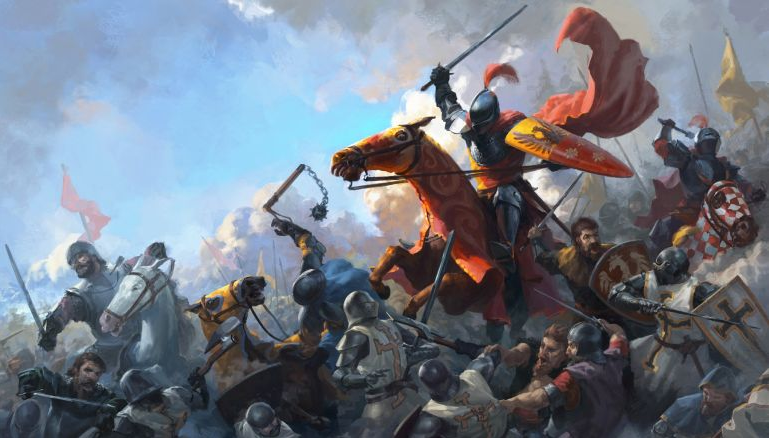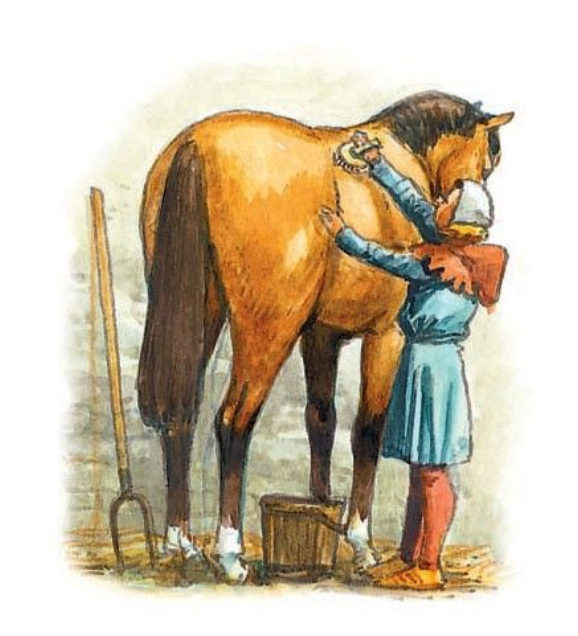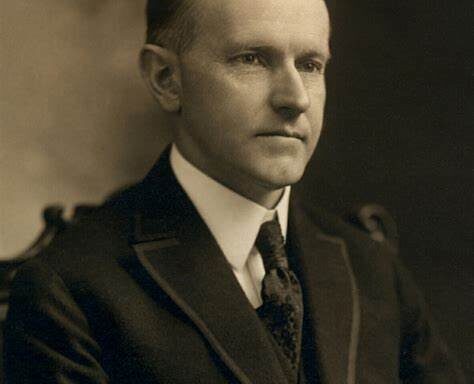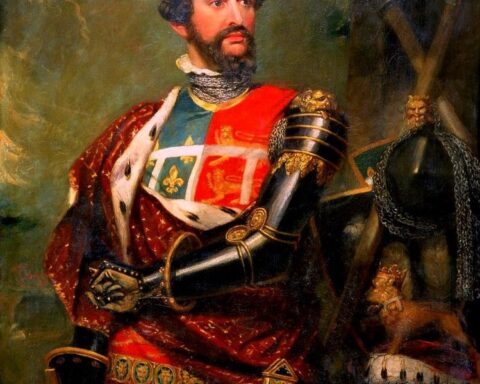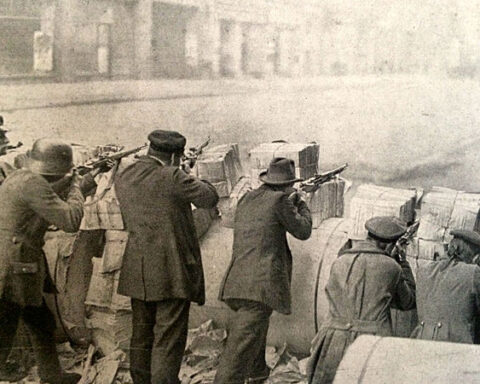Editor’s note: The following comprises Chapter 4 of Chivalry, by F. Warre Cornish (published 1901). Original footnotes are abridged.
(Continued from Part 3)
The art and practice of mediaeval warfare does not come directly within the limits of this work. But warfare was the principal occupation of the knight, whether for business or pleasure; the heyday of chivalry was the period during which cavalry was in the ascendant, and its decline was chiefly due to that development of the art of war which gave the issue of battles to infantry and artillery rather than cavalry, and made the conduct of campaigns and sieges a matter of calculation rather than of personal prowess. It is therefore necessary to give a short sketch of military history during the chivalric period, i.e. from the 10th to the 15th or 16th century. The cavalry period, however, dates from a time far anterior to chivalry.
The battle of Adrianople between the Romans and the Goths, 378 A.D., is cited by Mr. Oman in his History of the Art of War as the first, the battle of Marignano, 1515, as the last of the triumphs of the mediaeval horseman.
At Adrianople the imperial infantry, no longer able, by the use of superior armour, discipline, and individual skill and courage, to keep the Gothic cavalry at a distance, but driven in upon itself and huddled together in a helpless mass, was destroyed by the Gothic cavalry breaking in upon its flank. Where cavalry can be brought into the field in sufficient numbers, and the opposing infantry are not well provided with archers, slingers or javelin men, they can ride infantry down, unless, as in the Macedonian or the Swiss phalanx, the front of pikes is too deep to be broken through. But cavalry is useful for attack, not for defence. ‘The horse,’ it has been said, ‘is the weapon;’ the impact of a mass of men and horses at full speed is what tells. Wounded horses encumber and endanger a defensive position. The main use of cavalry, then, is not to hold but to gain a position; and when infantry have to resist cavalry, it must be done by the employment of archery (or musketry) to weaken the attack whilst it is being delivered, and before it can be driven home. A modern instance of the weakness of cavalry for defence is that of the Russian horse at Balaklava, which broke up under the charge of the English heavy brigade. The lesson of mediaeval warfare, learnt and forgotten on innumerable fields, was the right use of archers and infantry against cavalry: but the feudal pride of the man-at-arms was proof against conviction until horse and foot bowed before the power of artillery.
The Franks who overran the Gaulish provinces fought on foot, armed with spear, sword, and battle axe, the formidable francisca or tomahawk, more effective when thrown than at close quarters. By degrees the Franks adopted the use of the horse and of body-armour. The shirt of mail (brunia, the A.S. byrnie) was worn by all cavalry from the 6th century onward, and the Franks became more and more a nation of horsemen. But at Poictiers (732) the old tactics prevailed, and the Moslem light horse were met and routed, not by counter charges of cavalry, but by a solid phalanx of infantry and dismounted cavalry, built up ‘like a wall, or as if frozen together into a belt of ice;’ dismounted cavalry standing by the side of the infantry.
The Danish raiders, arriving suddenly and departing as suddenly, taught the menaced nation how little trust was to be placed in national levies, ill armed, undisciplined, slow to muster, and soon dispersed. Before the English Ealdorman could get the men of the shire together, or the Frankish lord collect his dependants, the Dane had come up the river, beached his keels, seized all the horses in the neighbourhood, burnt villages, manors and abbeys, and was gone again with his plunder and his captives.
The Danes, when they had advanced from raiding to the maintenance of dyked and stockaded forts, and from forts to settlements in tracts of land, being the best soldiers of their time, and having an unusual aptitude for the adoption of new ideas, beat the Franks at their own weapons. To meet the Frankish cavalry, the Scandinavian settlers in Gaul learnt to fight on horseback; and by the beginning of the 11th century the Norman cavalry was the best in Europe.
The English made little use of cavalry before the Conquest. The ‘hard hand-play’ of Ashdown (871) Ethandun (878) and Brunanburh (937) was a combat of axes and short swords (seaxe) hewing down the shield-wall, behind which stood the chiefs, dismounted. The same simple tactics were followed at Stamford Bridge and Hastings, (1066) where Harold and Gurth fought on foot. Whilst the shield-wall formation, whether in line, ring, or triangle, remained unbroken, the cavalry were at a disadvantage; for the horse will not easily face a double or triple hedge of pikes; the squares at Waterloo are a modern instance. If the cavalry could force an entrance, as at Stamford Bridge and at Hastings, the infantry were at their mercy. The varieties of battles are infinite; in some the infantry largely outnumber the cavalry, in some the proportion is reversed; some are combats of cavalry alone, in others archers and slingers decide the day. Horse prevailed over foot in the cavalry period, because that arm was highly organised, and generals gave little attention to the handling of infantry; the importance of infantry was increased with the development of archery.
The English levies, untrained and half-armed, were, when opposed to the Danes, as militia against regular soldiers. The Danes met the natives, whenever they gathered head, with broadsword, spear, and battle-axe. Every Northman considered himself a match for three enemies — from four he might fly without discredit.
Mediaeval warfare thus organised itself as cavalry; and battles were mainly decided by charges of knights in mail slaughtering hosts of infantry, or were contests of cavalry alone, whether in the field or in the streets of a town. The battle of Bouvines (1215) was a huge scramble and scuffle of men and horses; ‘a vast tourney,’ diversified like a Homeric fight by ‘an infinite number of single combats.’ The battle of Val ès Dunes (1047) was ‘little more than a fierce combat of horse surging backwards and forwards over the slopes of the upland on which it was fought.’
In fact, the description of a mediaeval battle is the description of feats of arms done by the captains. A battle was a tournament on a grander and more dangerous scale, in which, besides the chance of death and wounds, the knight ran the risk of being butchered by the ‘ribauds’ who despatched the wounded after the mailed cavalry had swept by, or thrown into a dungeon where rats and mice (as Du Guesclin said,) were more plentiful than song-birds. The honour to be gained was greater in proportion; and devotion to a sovereign or liege lord, to the Christian cause against the infidel, and to some extent and in some cases patriotism, as in the wars between France and England, or between England and Scotland, was a less incentive to deeds of prowess than personal pride and the love of ladies.
The knights of the Temple and the Hospital, of Calatrava and St. James, showed their prowess in the battles of the crusaders in the East and in Spain; overthrowing the Paynim cavalry by sheer weight of man and horse, battle meeting battle, and champions doing great feats of arms. At Mansourah, the last pitched battle of the Crusades (1251), the Count of Artois had no better plan of battle than to charge the Saracens as soon as he came in sight of them, without waiting for the main body to come up, regardless of the promise made to his brother. King Lewis. Squadron after squadron charged and was destroyed in detail, either in the open field, or in the narrow streets of the town. If Artois had waited to allow the whole army to assemble, and the enemy had then been engaged with infantry, cross-bowmen and horse, a great victory would have been won, and ‘Islam would have been ruined,’ as the Moslem historians themselves confess. The battle of Lewes was lost by the desire of Prince Edward to avenge upon the Londoners an insult offered to his mother, which led him, like his descendant Rupert, into a headlong charge far away from the main scene of action. De Montfort, the next year, was defeated at Evesham by a simple strategical combination; and his army was destroyed by a force numerous enough to engage them at once in front and rear. Had Edward’s troops come on in one mass, a charge of the baronial cavalry might have checked them, or even broken through. Yet even this plain device was claimed by Montfort as his own. ‘By the arm of St. James,’ he cried, ‘I taught them how to fight.’ This battle, like others, was but a mêlée of cavalry in which numbers prevailed, as they must where there is no surprise, no reserve, no supports of archery or other long-range weapons, no unexpected and effective charge, and where one party is as skilled as the other.
‘Chevaucher’ is the whole duty of a gentleman in arms, according to Froissart. Like ‘a certain lord’ in Shakespeare’s Henry IV, he looks upon the disturbance of the knightly mêlée by infantry (ribauds, brigands à pied) and archers, as ‘great pity.’
We pause for a moment to consider what a magnificent military engine, within its limits, the mounted knight or man-at-arms must have been. None but the heaviest horses could carry riders weighted from head to foot with chain armour, and bearing shield, lance, sword, and sometimes axe and mace. Such a horse and man weighed many hundreds of pounds, and the shock of a body of them charging together was irresistible. When arrived at close quarters, the knight was a skilled fighter, trained all his life in horsemanship and the use of arms. He was one of an exclusive class, raised above all others; he was animated, within his own class, by a spirit of the keenest personal rivalry; love and war combined to exalt his courage; and he was often the servant of God fighting the battle of the Cross against the infidel, and confident of salvation if he fell.
Although throughout the Middle Ages there was no school of military science, contact with the East was not without its effect upon the art of war. In military organisation, as in all the arts of life, the Byzantines of the 11th century were far ahead of the Western nations. They had preserved the Roman tradition of castrametation; they had siege trains, and even ambulances and surgeons; they arranged their forces in battle so as to support and assist each other; and the whole art of building, attacking and defending castles was brought back from the East into Europe, where as yet it hardly existed.
The Crusades provided a new school of war. The soldiers of the Cross had everything to learn. Effective discipline was almost unknown among them; combination of forces in subordination to a general in chief, and support of one arm by another, if dreamed of by a few captains, were liable to be disconcerted by any obstinate or hot-headed lord of a few hundred men-at-arms. Mediaeval nobles were as jealous of each other, and as unwilling to obey a common leader, as the Grecian chiefs who fought against Xerxes. They were as quarrelsome as dogs, as impracticable as field-deputies, as punctilious as ambassadors. The Templars would fight nowhere but on the right wing, and in like manner the Knights of St. John claimed the left. A count disdained to serve under a baron, a duke under a count, a German under a Frenchman or Englishman. The Flemish knights at Bouvines refused to charge a body of infantry because they were not gentlemen, and so lost the battle. The memoirs of Villehardouin and Joinville, as well as those of Froissart and Monstrelet, are full of the records of the pride and ill-temper which endangered the greatest objects of the campaigns they describe. The want of discipline, as well as the short term of feudal service in the field, led to the gradual substitution of paid troops for cavalry in all the armies of Europe. When to this indiscipline we add a total ignorance of geographical knowledge, (the sole cause of the double failure of Lewis IX) defective commissariat and means of transport, ignorant contempt of strategy, and inexperience in siege operations, we wonder that the Crusaders should have prevailed at all.
The lesson to be learnt from the Crusades was that to win battles it was necessary to combine infantry and cavalry in the line of battle, and to support both by a strong force of archers, on foot or on horseback. But lessons of victory and defeat alike seem to have been lost on the mediaeval generals. They came back from the Holy Land for the most part as ignorant as they went. Only two, Richard I and Edward I, both men of great military ability, seem to have profited by their experience as Crusaders; and each of them showed his ability by applying his experience to new conditions.
Richard I, however, (in spite of Ivanhoe) did not know the English longbow. It was this weapon, as all the world knows, which determined the superiority of the English battle in the Edwardian wars with Scotland and France. It is not certain when or how the longbow became the English weapon. The English at Hastings, as well as the Normans, are represented in the Bayeux tapestry as using the short horseman’s bow, and drawling the arrow to the breast, not to the ear.[1] The bow is not mentioned in the Assize of Arms in 1181; and there is little account of English archery till the wars of Edward I in Wales and Scotland. The Crusaders employed the crossbow, a long-range weapon, but clumsy and slow, and did not arm their knights with the short bow used with much effect by the Moslem cavalry. A man-at-arms had enough weapons to carry without being cumbered with bow and quiver; and the man-at-arms was so complete a military instrument, and so far superior in effectiveness to all others when properly handled, that it would have seemed folly to put him to a different use.
The 6-foot longbow, carrying a cloth-yard shaft, and drawn to the ear, had a greater velocity and range than the short bow, could be discharged much more rapidly than the crossbow, and could be brought to a high standard of precision. Once adopted, there was no question of its disuse. That it was never taken up by continental nations is probably, at least in part, owing to the fact that skill in it could only be obtained by long practice, which nothing but national habit could give. Archery, which formed no part of chivalric training, was the favourite pastime of the English yeomanry, and their chief pride in war. The English archer was not a mere rank-and-file man. He was a skilled craftsman using the best weapon in the world; and had all the self-respect of the Tyrolese, Boer, or American rifleman.
Edward I, himself the flower of knighthood, was the first to make effective use of the longbow, the churl’s weapon and destined to destroy the knight’s monopoly. His cavalry could not break the squares of Welsh pikemen, till he placed archers between his men at arms, and dispersed the phalanx of infantry.
The Scots, like the English before the Conquest, were weak in cavalry, and relied upon their yeomen, armed with the pike, and capable of dogged resistance and steady advance. They could not be scattered by a sudden charge like the gallant but unstable Welsh: they must be broken up before the shock was given ; unbroken, no cavalry could shake them. At Falkirk (1298) Wallace had a thousand horse and a few thousand archers posted on the flanks : but his whole trust was in his four ‘schiltrouns’ [2] of pikemen, ‘impenetrable masses of spears,,’ numbering perhaps thirty thousand in all. The English knights attacked both flanks of the Scots, rode down their archers, and were driven off by the infantry: for Wallace’s horse, stationed in the rear of his infantry, left the field without striking a blow. The English might have charged many times without breaking up the schiltrouns, as they did a few years later at Bannockburn: but Edward I brought up his own archers, bade them concentrate their fire on certain points in the Scottish squares, and sent his cavalry in at the gaps thus made.
At Bannockburn, the Scots infantry, with the advantage of position, a narrow front and defended flanks, routed three times their number of horse, foot, and archers, because the English commanders had so arranged them that the archers, numbering some thirty thousand, [3] hardly came into action, and the cavalry failed to break the squares. Edward II should have known that the Scots could not be ridden down; and that to crowd fifty or sixty thousand men into a front little more than a mile long was to make the enemy a present of his advantage in numbers.
Want of space compels me to pass rapidly over the French wars of Edward III and his successors. The new conditions to be met were, for the English, how to encounter a military force more numerous than their own, and specially strong in heavy cavalry; for the French, how to neutralise the superiority of the English archers over their own arbalestry. The English leader studied his problem and solved it. The French despised their enemy, and were punished for doing so.
Everyone knows that at Crecy, as afterwards at Poictiers, the English ought to have been beaten, and that on both occasions the English longbow won the day. Edward III was ‘a bad strategist but a good tactician.’ He ought not to have been at Crecy on the 28th of August, 1346: but being there, he did the best that could be done. More than half his army were archers. He dismounted his men-at-arms, and posted his archers as advancing wings on each side of both the ‘battles’ of infantry.
‘From the day of Crecy,’ (writes J. R. Green) ‘feudalism tottered slowly but surely to its grave… The churl had struck down the noble.’ But it is interesting to note how little Froissart knows of this. To him, as the princes and lords, and to Francis I a hundred and fifty years later, chivalry and heraldry were more than the art of war, and he writes as if the French defeat were an unfortunate accident, not a matter of cause and effect; not perceiving that the destinies of war had passed away from the knight in armour to the archer and the pike-man, the mere pawns (as it seemed to him) of the noble game, ‘la piétaille,’ ‘la valetaille.’ Crecy and Poictiers were lost in great measure by the pride of the French nobles, who could see no further than to the end of their own lances; and were won by commanders who studied military efficiency more than knightly etiquette.
With the end of the French wars of Edward III we come upon an unexpected obstacle in the way of the English conquests. Just as the French were improving body-armour so as to be able to repel the English arrows, the supply of English archery began to run short. Such a supply could only be found in perfection in a national levy; and the place of the levy was beginning to be taken by mercenary troops, either ‘free companies,’[4] or troops furnished by ‘indenture,’ i.e., contract: a form of military taxation more convenient to the king and less burdensome to the subject than the personal levy.
The battles of the Wars of the Roses were fought by infantry; some of whom were raised by royal commission or parliamentary vote, some hired, some came as retainers of the great lords; and ‘villainous saltpetre’ at last put an end to the superiority of the knightly mêlée, and with it to the superiority of the ‘gentle’ class.
The short and uncertain service of feudal barons suited neither the immediate convenience of a king of France or England, nor the establishment of his power. The great wars of the fourteenth century created a class of soldiers ready to sell their services to any cause. But before this, sovereigns in all countries had been aware of the convenience and advantage of mercenaries. Henry II struck a blow at feudalism by accepting scutage in lieu of service. Philip the Fair had a considerable standing army in his pay. Whilst declaring the universal obligation of military service, he accepted money and substitutes in lieu of personal attendance. The king’s ost, furnished in part by feudal vassals subject to the ban, was also made up by paid bodies of infantry, crossbowmen and men-at-arms, or gendarmes, the latter denoting, not the chivalry of France, but light and heavy cavalry armed in the same manner as the knights, and serving for fixed pay.[5] Charles VII had a force of 1500 gendarmes, each of whom served with six horses. Lewis XI employed mercenaries from all countries, and from his time the place of the seignorial levies is taken by a royal army. Compagnies d’ ordonnance, Free Companies, Landsknechts, are so many names for armies to be bought in the market. The contractor, commonly known in Italy by the name of condottiere, made war his trade and managed it on business principles. His men were well clothed, armed, and fed, and received regular pay. They were trained in all the latest developments of war, and could meet the old-fashioned chivalry on their own ground and bewilder them with new inventions in archery, artillery, and infantry. No warlike sovereign could dispense with the Free Companies. They took the place held by the Templars and Hospitallers in the Holy Wars, and like them were preferred to the feudal levies as being better troops and more obedient to orders. But what a downfall in sentiment! At the siege of Padua (1509) Bayard refused to let the gentlemen of France fight side by side with Landsknechts, who had no distinction of birth, no rule of honour, no patriotism, no principle except to fulfil the terms of a bargain, no idea of pleasure except the excitement of a fight and the license of free quarters, or the sack of a town.
Hallam instances one of these mercenaries who marched about Italy without a master to pay him or a cause to defend, levying black-mail wherever he went. Werner, a German Landsknecht, had engraved on his cuirass ‘Enemy of God, pity and mercy.’ The ‘Great Company’ of 1353 consisted of 20,000 men, horse and foot, whose only business was to plunder; and the city of Florence, which refused to submit to their exactions, could only meet them with hired troops like themselves. Sir John Hawkwood (d. 1393) whose monument adorns the Cathedral of Florence, was one of the most eminent as well as the most respectable of these soldiers of fortune, whose dreary track of bloodshed and devastation seared the face of Europe, till they came to their worst notoriety under Mansfeld, Wallenstein, and Tilly in the Thirty Years’ War. The actual profession of condottiere was too unnatural to be permanent; but the ill example of buying trained soldiers, instead of bearing arms, fell in with the convenience of princes and subjects, systematised, and at the same time dishonoured war, and put an end to chivalry as a factor in military affairs. In chivalry, any knight might serve under what captain he chose and do what deeds he chose — now he must take his chance, as we should say, with his regiment, and ‘not run risks’ — a bourgeois conception of war.
One of the many points of difference between the feudal chivalry of England and that of other countries is illustrated by the comparatively small number of castles. The knight of the Middle Ages spent a good part of his time in fighting the battles of his lord, whether in the larger operations of war, or in the petty disputes between castle and castle. The more perfectly the feudal system was developed, or (in other words) the greater the number of independent or nearly independent princes, the more licence was there of private war. Thus there was more private war in Germany than in France, in France than in Italy. As a general rule, castles were more abundant in mountainous districts than in the plain. The reason is twofold. It was more easy, in the first place, to set up impregnable fastnesses in the hills than in the plain, where they could be surrounded and starved out — the only method, except treachery, of taking a castle with walls twenty feet thick and towers fifty feet high; a fact always to be borne in mind in mediaeval warfare — and in the second place, civic life is opposed to war: the interests of a town are peaceful in the main, and the feuds of Montagues and Capulets, Orsinis and Colonnas, so common in Italian cities, belong to a date when the civic spirit had decayed, and given place to the spirit of family pride and chivalry, which is incompatible with it.
In England, before the Conquest, the habits of the nation were opposed to war. Both Danes and Normans found the English an easy conquest, because they wanted, not courage and arms, but organisation. The English had no disciplined militia or armed nobility. They built few castles, and such as they had were of timber; and when the Norman kings built castles of stone, they kept the custody of them in their own hands. Stephen and John, the first from weakness, the second because he was the enemy of his subjects, lost the control of the royal castles, and permitted the erection of others: and the spirit of chivalry broke out at once in private war. The beginning of Henry III’s reign was occupied by the reduction of castles into the hands of Hubert de Burgh, the king’s minister. When Henry’s misrule made the Baronage his enemies, the Barons’ War was a struggle for the possession of castles: and it was so understood by both parties. The King’s party, having once regained the castles, was able to rule temperately, and without resistance. The strong government of Edward I put an end for ever to private war and knight-errantry. Scutage, invented by Henry I and organised by Henry II, i.e., the substitution of money payment for feudal service in person, and the later engaging of a mercenary army by ‘indenture’ or agreement with a feudal lord for the services of his dependants, worked the same way, and tended both to increase the royal power, and to keep the English a peaceful nation. The home force, the native militia or fyrd, was principally employed in border warfare, and the armies which fought in France and in the Holy Land were chiefly composed of paid soldiers, though they contained also bodies of feudal cavalry, supplied by the chivalry of England.
It follows from this that the lords and knights of England had not that constant practice in war which made the feudal cavalry of Europe so formidable; and as practice in war was that which gave its reality to chivalry, the perfection, or extravagance, of chivalry is to be found in France rather than in this country.
______________________________________
[1] The Bayeux tapestry is a Norman work, and not necessarily accurate in depicting the English.
[2] The word is variously spelt ‘schiltron,’ ‘schiltrom,’ and ‘schiltroun.’
[3] Mediaeval (and modern) computations of numbers are not wholly to be trusted.
[4] They are also termed routiers, Brabançons, tard-venus.
[5] Each gendarme was attended by two archers and two horsemen. This complement of five men (later seven) was known as a ‘lance’ or a ‘man-at-arms,’ and this nomenclature was applied to the chivalry also.

